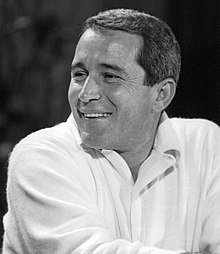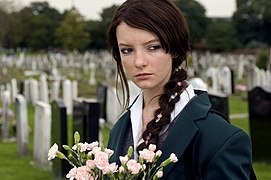Portal:Television
The Television Portal

Television (TV) is a telecommunication medium for transmitting moving images and sound. The term can refer to a television set, or the medium of television transmission. Television is a mass medium for advertising, entertainment, news, and sports.
Television became available in crude experimental forms in the 1920s, but only after several years of further development was the new technology marketed to consumers. After World War II, an improved form of black-and-white television broadcasting became popular in the United Kingdom and the United States, and television sets became commonplace in homes, businesses, and institutions. During the 1950s, television was the primary medium for influencing public opinion. In the mid-1960s, color broadcasting was introduced in the U.S. and most other developed countries.
In 2013, 79% of the world's households owned a television set. The replacement of earlier cathode-ray tube (CRT) screen displays with compact, energy-efficient, flat-panel alternative technologies such as LCDs (both fluorescent-backlit and LED), OLED displays, and plasma displays was a hardware revolution that began with computer monitors in the late 1990s. Most television sets sold in the 2000s were flat-panel, mainly LEDs. Major manufacturers announced the discontinuation of CRT, Digital Light Processing (DLP), plasma, and even fluorescent-backlit LCDs by the mid-2010s. LEDs are being gradually replaced by OLEDs. Also, major manufacturers have started increasingly producing smart TVs in the mid-2010s. Smart TVs with integrated Internet and Web 2.0 functions became the dominant form of television by the late 2010s. (Full article...)
Selected article -
Pride and Prejudice is a six-episode 1995 British television drama, adapted by Andrew Davies from Jane Austen's 1813 novel of the same name. Jennifer Ehle and Colin Firth starred as Elizabeth Bennet and Fitzwilliam Darcy, respectively. Produced by Sue Birtwistle and directed by Simon Langton, the serial was a BBC production with additional funding from the American A&E Network. BBC1 originally broadcast the 55-minute episodes from 24 September to 29 October 1995. The A&E Network aired the series in double episodes on three consecutive nights beginning 14 January 1996.
Critically acclaimed and a popular success, Pride and Prejudice was honoured with several awards, including a BAFTA Television Award for Jennifer Ehle for "Best Actress" and an Emmy for "Outstanding Individual Achievement in Costume Design for a Miniseries or a Special". The role of Mr Darcy elevated Colin Firth to stardom. A scene showing Firth in a wet shirt was recognised as "one of the most unforgettable moments in British TV history". The New York Times called the adaptation "a witty mix of love stories and social conniving, cleverly wrapped in the ambitions and illusions of a provincial gentry". The series inspired author Helen Fielding to write the popular Bridget Jones novels, and their screen adaptations subsequently featured Firth as Bridget's love interest, Mark Darcy.
Selected image -

The Jacob's Awards were instituted in December 1962 as the first Irish television awards. Later, they were expanded to include radio. The awards were named after their sponsor, W. & R. Jacob & Co. Ltd., a biscuit manufacturer, and recipients were selected by Ireland's national newspaper TV and radio critics. Jacob's Award winners were chosen annually until 1993, when the final awards presentation took place.
Did you know (auto-generated) -

- ... that Svalbard Minute by Minute, a 221-hour-long television broadcast, is credited with increasing tourism in Svalbard by 25 percent?
- ... that the day employees of Boston television station WLVI received new business cards, they learned the station would be sold and they would lose their jobs?
- ... that as general director of the Grand Theatre in Łódź, bass singer Kazimierz Kowalski led a worldwide television broadcast of Moniuszko's The Haunted Manor?
- ... that Toshiki Seto was cast in the television adaptation of Senpai, This Can't Be Love! because, according to the creator, he could express emotion through his stare?
- ... that in the television series sequel Imortal (2010), Angel Locsin portrayed the lead role as the daughter of her lycan character in the Lobo TV series?
- ... that the 1992 documentary film Daddy and the Muscle Academy, which focuses on the life of gay erotic artist Tom of Finland, has been broadcast on Finnish television multiple times?
Selected quote -
More did you know
- ...that David Letterman parodied Werner Erhard in the 1978 Mork & Mindy episode Mork Goes Erk?
- ...that despite British Conservative MP Denis Keegan winning a marginal constituency by over 7,000 votes, he ended his political career after one term, preferring to work for the trade association for television shops?
- ...that the participants of the Channel 4 programme Dumped were not told that they would be living on a landfill site for three weeks?
- ...that Tomorrow's Pioneers, a television program for children produced by Hamas, features a mascot similar to Mickey Mouse?
- ...that a Spokane, Washington, television station devoted the first 11 minutes of its Saturday evening newscast to the February 2007 arrests of Gonzaga University basketball player Josh Heytvelt and his teammate?
Selected biography -
Pierino Ronald "Perry" Como (/ˈkoʊmoʊ/; May 18, 1912 – May 12, 2001) was an American singer, actor, and television personality. During a career spanning more than half a century, he recorded exclusively for RCA Victor for 44 years, from 1943 until 1987.
"Mr. C.", as he was nicknamed, reportedly sold over 100 million records worldwide and pioneered a weekly musical variety television show. His weekly television shows and seasonal specials were broadcast throughout the world. He recorded primarily vocal pop and was renowned for recordings in the intimate, easy-listening genre pioneered by multimedia star Bing Crosby. In the official RCA Records Billboard magazine memorial, his life was summed up in these few words: "50 years of music and a life well lived. An example to all." (Full article...)General images

Glee is an American musical comedy-drama television series that aired on the Fox network in the United States. It focuses on the William McKinley High School glee club New Directions competing on the show choir competition circuit, while its members deal with relationships, sexuality and social issues. The show was created by Ryan Murphy, Brad Falchuk and Ian Brennan, and features many cover versions of songs performed on-screen by the characters. Murphy is responsible for selecting all of the songs used, and strives to maintain a balance between show tunes and chart hits, as he wants there to be "something for everybody in every episode". Once Murphy selects a song, rights are cleared with its publishers by music supervisor P.J. Bloom, and music producer Adam Anders rearranges it for the Glee cast. Numbers are pre-recorded by the cast, while choreographer Zach Woodlee constructs the accompanying dance moves, which are then taught to the cast and filmed. Studio recordings of tracks are then made. The process begins six to eight weeks before each episode is filmed, and can end as late as the day before filming begins.
At the beginning of the season, Murphy intended for the performances to remain reality-based, as opposed to having the characters spontaneously burst into song. As the season progressed, however, Glee began to utilize fantasy sequences, with paraplegic character Artie imagining himself dancing to "The Safety Dance", and six separate characters performing a fantasy version of "Like a Virgin". The first thirteen episodes of the season averaged five songs per episode. For the final nine episodes, the number of performances increased to eight. The list below contains all 132 musical performances of the first season, with each performance delivering an individual song or a mashup of two or more songs in a single performance. (Full article...)
Transliteration: "Shinigami ni Natchatta Hi" (Japanese: 死神になっちゃった日)Noriyuki AbeNoriyuki AbeMasashi SogoOctober 5, 2004September 9, 2006
2"A Shinigami's Work"
Transliteration: "Shinigami no Oshigoto" (Japanese: 死神のお仕事)Jun'ya KoshibaJun'ya KoshibaNatsuko TakahashiOctober 12, 2004September 16, 2006
3"The Older Brother's Wish, the Younger Sister's Wish"
Transliteration: "Ani no Negai, Imōto no Negai" (Japanese: 兄の願い、妹の願い)Noriyuki AbeShigeki HatakeyamaNatsuko TakahashiOctober 19, 2004September 23, 2006
4"Cursed Parakeet"
Transliteration: "Noroi no Inko" (Japanese: 呪いのインコ)Hidehito UedaTakuji KimuraGenki YoshimuraOctober 26, 2004September 30, 2006
5"Beat the Invisible Enemy!"
Transliteration: "Mienai Teki o Nagure!" (Japanese: 見えない敵を殴れ!)Tetsuhito SaitōKazunori MizunoGenki YoshimuraNovember 2, 2004October 7, 2006
6"Fight to the Death! Ichigo vs. Ichigo"
Transliteration: "Shitō! Ichigo VS Ichigo" (Japanese: 死闘!一護VSイチゴ)Motosuke TakahashiJun'ya KoshibaMichiko YokoteNovember 9, 2004October 14, 2006
7"Greetings from a Stuffed Lion"
Transliteration: "Nuigurumi kara Konnichiwa" (Japanese: ぬいぐるみからコンにちは)Motosuke Takahashi
Shigeki HatakeyamaAkira ShimizuMichiko Yokote
Masashi SogoNovember 16, 2004October 21, 2006
8"June 17, Memories in the Rain"
Transliteration: "Roku-gatsu Jūshichi-nichi, Ame no Kioku" (Japanese: 6月17日、雨の記憶)Noriyuki AbeShigeki HatakeyamaMasashi SogoNovember 23, 2004October 28, 2006
9"Unbeatable Enemy"
Transliteration: "Taosenai Teki" (Japanese: 倒せない敵)Sanzō TsunodaTakuji KimuraMasashi SogoNovember 30, 2004November 4, 2006
10"Assault on Trip at Sacred Ground!"
Transliteration: "Burari Reijō Totsugeki no Tabi!" (Japanese: ぶらり霊場突撃の旅!)Kazunori MizunoKazunori MizunoMasahiro ŌkuboDecember 7, 2004November 11, 2006
11"The Legendary Quincy"
Transliteration: "Densetsu no Kuinshī" (Japanese: 伝説のクインシー)Jun'ya KoshibaJun'ya KoshibaMichiko YokoteDecember 14, 2004November 18, 2006
12"A Gentle Right Arm"
Transliteration: "Yasashii Migiude" (Japanese: やさしい右腕)Kōji AritomiKōji AritomiGenki YoshimuraDecember 21, 2004November 25, 2006
13"Flower and Hollow"
Transliteration: "Hana to Horō" (Japanese: 花とホロウ)Sanzō TsunodaTakuji KimuraNatsuko TakahashiDecember 28, 2004December 2, 2006
14"Back to Back, a Fight to the Death!"
Transliteration: "Senaka Awase no Shitō!" (Japanese: 背中合わせの死闘!)Tetsuhito SaitōNoriyuki AbeMasashi SogoJanuary 11, 2005December 9, 2006
15"Kon's Great Plan"
Transliteration: "Kon no Uhauha Daisakusen" (Japanese: コンのウハウハ大作戦)Chiaki KonChiaki KonMasahiro ŌkuboJanuary 18, 2005December 16, 2006
16"The Encounter, Abarai Renji!"
Transliteration: "Abarai Renji, Kenzan!" (Japanese: 阿散井恋次、見参!)Motosuke TakahashiJun'ya KoshibaMichiko YokoteJanuary 25, 2005January 6, 2007
17"Ichigo Dies!"
Transliteration: "Ichigo, Shisu!" (Japanese: 一護、死す!)Manabu FukazawaKazunori MizunoRika NakaseFebruary 1, 2005January 13, 2007
18"Reclaim! The Power of the Shinigami!"
Transliteration: "Torimodose! Shinigami no Chikara!" (Japanese: 取り戻せ!死神の力!)Jun'ya KoshibaAkira ShimizuNatsuko TakahashiFebruary 8, 2005January 20, 2007
19"Ichigo Becomes a Hollow!"
Transliteration: "Ichigo, Horō ni Ochiru!" (Japanese: 一護、ホロウに墜ちる!)Tetsuhito SaitōTakuji KimuraGenki YoshimuraFebruary 15, 2005January 27, 2007
20"Ichimaru Gin's Shadow"
Transliteration: "Ichimaru Gin no Kage" (Japanese: 市丸ギンの影)Shigeki HatakeyamaShigeki HatakeyamaMasashi SogoFebruary 22, 2005February 3, 2007 (Full article...)

The British documentary series Chartjackers ran for a single season of eleven weekly episodes during the autumn of 2009. The series documents the lives of four teenage video bloggers—Alex Day, Johnny Haggart, Jimmy Hill, and Charlie McDonnell—from the video-sharing website YouTube as they attempt to write, record and release a pop song by crowdsourcing through social media in ten weeks. When initially aired, the first ten episodes of Chartjackers, each five minutes in length, detailed the events of the previous seven days. The final episode, broadcast on 21 November 2009, compiled highlights from the previous ten weeks into one 30-minute episode, which was narrated by British DJ MistaJam. All eleven episodes were produced by Adam King and Jonathan Davenport of the production company Hat Trick Productions.
Chartjackers was devised in 2009 by Davenport and Andy Mettam of Hat Trick Productions, and was commissioned for development by Geoffrey Goodwin and Jo Twist of BBC Switch. Alongside the programmes Off the Hook and The Cut, it was featured as part of a season of multi-platform content designed to appeal to teenagers. The show was also directly linked to the 2009 annual appeal for the British charity Children in Need – profits from sales of the completed pop song were donated to the charity. Chartjackers aired weekly at approximately 1:10 p.m. on Saturday afternoons on BBC Two, with the first episode premiering on 12 September 2009 during the channel's two-hour long BBC Switch segment. The series garnered a viewing figures peak of almost half a million with its final episode and was critically panned by reviewers. Each episode was streamed online through BBC iPlayer to UK residents for seven days after its initial airing. The series was not broadcast outside the UK and, , is not available to buy on DVD. (Full article...)
| Season | Episodes | Originally aired | Rank | Rating | ||
|---|---|---|---|---|---|---|
| First aired | Last aired | |||||
| 1 | 24 | September 17, 1972 | March 25, 1973 | 46 | 17.5 | |
| 2 | 24 | September 15, 1973 | March 2, 1974 | 4 | 25.7 | |
| 3 | 24 | September 10, 1974 | March 18, 1975 | 5 | 27.4 | |
| 4 | 25 | September 12, 1975 | February 24, 1976 | 14 | 22.9 | |
| 5 | 25 | September 21, 1976 | March 15, 1977 | 4 | 25.9 | |
| 6 | 25 | September 20, 1977 | March 27, 1978 | 8 | 23.2 | |
| 7 | 26 | September 18, 1978 | March 12, 1979 | 7 | 25.4 | |
| 8 | 25 | September 17, 1979 | March 24, 1980 | 4 | 25.3 | |
| 9 | 20 | November 17, 1980 | May 4, 1981 | 4 | 25.7 | |
| 10 | 22 | October 26, 1981 | April 12, 1982 | 9 | 22.3 | |
| 11 | 16 | October 25, 1982 | February 28, 1983 | 3 | 22.6 | |
The episodes aired from October 2, 2007, to December 25, 2007, on Chiba TV and KBS Kyoto, with AT-X, Mie TV, Tokyo MX TV, TV Kanagawa, TV Saitama, and TV Wakayama showing the episodes at later dates. The AT-X broadcast started much later than its counterparts, with the first episode airing in November, while most other stations started showing the episodes in October. Unlike most Japanese anime, the title of each episode is given in English. Each title is the name of a flower shown in that episode. (Full article...)
News
- December 28: US professional wrestler Jon Huber dies aged 41
- September 2: Tributes paid to recently deceased US actor Chadwick Boseman
- May 24: Japanese professional wrestler and Netflix star Hana Kimura dies aged 22
- January 16: BBC newsreader Alagiah to undergo treatment for bowel cancer
- Upcoming events
Featured content
Main topics
History of television: Early television stations • Geographical usage of television • Golden Age of Television • List of experimental television stations • List of years in television • Mechanical television • Social aspects of television • Television systems before 1940 • Timeline of the introduction of television in countries • Timeline of the introduction of color television in countries
Inventors and pioneers: John Logie Baird • Alan Blumlein • Walter Bruch • Alan Archibald Campbell-Swinton • Allen B. DuMont • Philo Taylor Farnsworth • Charles Francis Jenkins • Boris Grabovsky • Paul Gottlieb Nipkow • Constantin Perskyi • Boris Rosing • David Sarnoff • Kálmán Tihanyi • Vladimir Zworykin
Technology: Comparison of display technology • Digital television • Liquid crystal display television • Large-screen television technology • Technology of television
Terms: Broadcast television systems • Composite monitor • HDTV • Liquid crystal display television • PAL • Picture-in-picture • Pay-per-view • Plasma display • NICAM • NTSC • SECAM
Categories
WikiProjects

|
You are invited to participate in WikiProject Television, a WikiProject dedicated to developing and improving articles about Television. |
- Main projects
- Sub-projects
Television Stations • American animation • American television • Australian television • British TV • BBC • Canadian TV shows • Television Game Shows • ITC Entertainment Productions • Digimon • Buffyverse • Doctor Who • Degrassi • EastEnders • Episode coverage • Firefly • Futurama • Grey's Anatomy • Indian television • Lost • Nickelodeon • The O.C. • Professional Wrestling • Reality TV • The Simpsons • Seinfeld • South Park • Stargate • Star Trek • Star Wars • Soap operas • Avatar: The Last Airbender • House
- Related projects
Animation • Anime and manga • Comedy • Comics • Fictional characters • Film • Media franchises
What are WikiProjects?
Things you can do

- Place the {{WikiProject Television}} project banner on the talk pages of all articles within the scope of the project.
- Write: Possible Possum
- Cleanup: color television, Alien Nation: Body and Soul, The Sopranos, Alien Nation: Dark Horizon, Alien Nation: The Enemy Within, Alien Nation: Millennium, Aang
- Expand: Timeline of the introduction of color television in countries
- Stubs: Flow (television), Just for Kicks (TV series), Play of the Month, Nova (Dutch TV series), More stubs...
Subportals
Related portals
Associated Wikimedia
The following Wikimedia Foundation sister projects provide more on this subject:
-
Commons
Free media repository -
Wikibooks
Free textbooks and manuals -
Wikidata
Free knowledge base -
Wikinews
Free-content news -
Wikiquote
Collection of quotations -
Wikisource
Free-content library -
Wikiversity
Free learning tools -
Wiktionary
Dictionary and thesaurus



























































